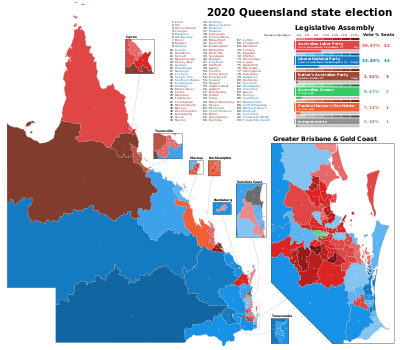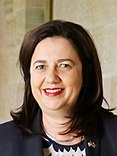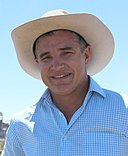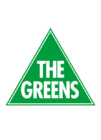The 2020 Queensland state election was held on 31 October to elect all 93 members to the 57th Legislative Assembly of Queensland. The Labor Party was returned to government for a third-term, led by incumbent premier Annastacia Palaszczuk.[2] With 47 seats needed to form a majority government, Labor won 52 seats, including all but five in Brisbane, while the Liberal National Party won 34 seats and formed opposition. On the crossbench, Katter's Australian Party retained its 3 seats, the Queensland Greens picked up South Brisbane for a total of 2, Pauline Hanson's One Nation retained Mirani and independent Sandy Bolton retained her seat of Noosa.
| |||||||||||||||||||||||||||||||||||||||||||||||||||||||||||||||||||||||||||||||||||||||||||||||||||||||||||||||||||||
All 93 seats in the Legislative Assembly of Queensland 47 seats needed for a majority | |||||||||||||||||||||||||||||||||||||||||||||||||||||||||||||||||||||||||||||||||||||||||||||||||||||||||||||||||||||
|---|---|---|---|---|---|---|---|---|---|---|---|---|---|---|---|---|---|---|---|---|---|---|---|---|---|---|---|---|---|---|---|---|---|---|---|---|---|---|---|---|---|---|---|---|---|---|---|---|---|---|---|---|---|---|---|---|---|---|---|---|---|---|---|---|---|---|---|---|---|---|---|---|---|---|---|---|---|---|---|---|---|---|---|---|---|---|---|---|---|---|---|---|---|---|---|---|---|---|---|---|---|---|---|---|---|---|---|---|---|---|---|---|---|---|---|---|---|
| Opinion polls | |||||||||||||||||||||||||||||||||||||||||||||||||||||||||||||||||||||||||||||||||||||||||||||||||||||||||||||||||||||
| Registered | 3,377,476 | ||||||||||||||||||||||||||||||||||||||||||||||||||||||||||||||||||||||||||||||||||||||||||||||||||||||||||||||||||||
| Turnout | 2,969,347 (87.92%) ( | ||||||||||||||||||||||||||||||||||||||||||||||||||||||||||||||||||||||||||||||||||||||||||||||||||||||||||||||||||||
| |||||||||||||||||||||||||||||||||||||||||||||||||||||||||||||||||||||||||||||||||||||||||||||||||||||||||||||||||||||
 Winning margin by electorate. | |||||||||||||||||||||||||||||||||||||||||||||||||||||||||||||||||||||||||||||||||||||||||||||||||||||||||||||||||||||
| |||||||||||||||||||||||||||||||||||||||||||||||||||||||||||||||||||||||||||||||||||||||||||||||||||||||||||||||||||||
Both major parties managed a small swing to them on primary votes, as a result of One Nation's vote sharply declining. On the two-party-preferred vote, Labor had a small swing to it statewide, though the party did notably lose some ground to the LNP in some key seats, including the ultra-marginal seats of Burdekin and Whitsunday, and the LNP also won both Toowoomba-based seats with increased majorities. Labor picked up five seats from the LNP, but notably sitting Deputy Premier Jackie Trad lost her seat of South Brisbane to the Greens.
At 11pm on 31 October, Liberal National Party leader Deb Frecklington conceded defeat, congratulating Palaszczuk on her victory.[2] Frecklington initially indicated that she would stay on as party leader, but on 2 November announced that she would convene a party meeting and resign as leader.[3] David Crisafulli won the ensuing leadership spill and was elected LNP leader on 12 November 2020.[4]
Palaszczuk became the first female party leader to win three state elections in Australia,[5] as well as the first Queensland Premier to increase their party's seat total across three successive elections.[6]
Results

| 52 | 2 | 1 | 1 | 3 | 34 |
| ALP | GRN | IND | ONP | KAP | LNP |
 | ||||||||||
| Party | Votes | % | Swing | Seats | +/– | |||||
|---|---|---|---|---|---|---|---|---|---|---|
| Labor | 1,134,969 | 39.57 | +4.14 | 52 |  4 4 | |||||
| Liberal National | 1,029,442 | 35.89 | +2.20 | 34 |  5 5 | |||||
| Greens | 271,514 | 9.47 | −0.53 | 2 |  1 1 | |||||
| One Nation | 204,316 | 7.12 | −6.60 | 1 |  | |||||
| Katter's Australian | 72,168 | 2.52 | +0.20 | 3 |  | |||||
| Legalise Cannabis | 26,146 | 0.91 | +0.91 | 0 |  | |||||
| United Australia | 17,904 | 0.62 | +0.62 | 0 |  | |||||
| Informed Medical Options | 17,546 | 0.61 | +0.61 | 0 |  | |||||
| Animal Justice | 9,703 | 0.34 | +0.34 | 0 |  | |||||
| North Queensland First | 5,616 | 0.20 | +0.20 | 0 |  | |||||
| Civil Liberties and Motorists | 5,207 | 0.18 | −0.08[b] | 0 |  | |||||
| Shooters, Fishers, Farmers | 2,801 | 0.10 | +0.10 | 0 |  | |||||
| Independents | 70,992 | 2.48 | −2.10 | 1 |  | |||||
| Formal votes | 2,868,324 | 96.60 | +0.94 | |||||||
| Informal votes | 101,023 | 3.40 | −0.94 | |||||||
| Total | 2,969,347 | 100 | 93 | |||||||
| Registered voters / turnout | 3,377,476 | 87.92 | +0.39 | |||||||
| Two-party-preferred vote[9] | ||||||||||
| Labor | 1,524,766 | 53.2 |  1.9 1.9 | |||||||
| Liberal National | 1,343,558 | 46.8 |  1.9 1.9 | |||||||
Vote summary
Seats changing hands
| Seat | 2017 Election | Swing | 2020 Election | ||||||
|---|---|---|---|---|---|---|---|---|---|
| Party | Member | Margin | Margin | Member | Party | ||||
| Bundaberg | Liberal National | David Batt | 4.20 | -4.21 | 0.01 | Tom Smith | Labor | ||
| Caloundra | Liberal National | Mark McArdle | 3.41 | -5.92 | 2.51 | Jason Hunt | Labor | ||
| Hervey Bay | Liberal National | Ted Sorensen | 9.10 | -11.12 | 2.02 | Adrian Tantari | Labor | ||
| Nicklin | Liberal National | Marty Hunt | 5.28 | -5.42 | 0.14 | Robert Skelton | Labor | ||
| Pumicestone | Liberal National | Simone Wilson | 0.84 | -6.11 | 5.27 | Ali King | Labor | ||
| South Brisbane | Labor | Jackie Trad | 3.55 | -8.90 | 5.35 | Amy MacMahon | Greens | ||
- Members listed in italics did not contest their seat at this election.
- The Liberal National Party also retained the seat of Whitsunday, where the sitting Liberal National member had resigned and contested the election as a member of their own party.
The swing between the major parties in each seat varied across the state. However, Labor managed a small statewide swing to it.
Queenslanders have been known to, at some points in time, vote for Labor on the state level and the LNP on the federal level; in 2019, when the federal Coalition government led by Scott Morrison was unexpectedly re-elected for a third consecutive term, the LNP won 23 of the 30 House of Representatives seats in Queensland and 58.44% of the two-party-preferred vote in the state, with Morrison's victory being credited to a stronger-than-expected performance in Queensland and Tasmania, despite Queensland having a state Labor government.
Ultimately, Labor managed to gain five seats from the LNP, including two Sunshine Coast seats (Caloundra and Nicklin), two seats in smaller regional cities (Bundaberg and Hervey Bay) and one seat in Brisbane (Pumicestone). However, Labor lost the seat of South Brisbane to the Greens, therefore giving Labor a net seat change of +4.
The seat of Bundaberg was won by Labor with a margin of just nine votes, currently the smallest margin of any federal or state electorate in Australia.
Labor's defeat in South Brisbane was significant in two ways. The Greens won their second state seat in Queensland, after winning Maiwar from the LNP in 2017. However, it also led to the defeat of sitting Deputy Premier Jackie Trad.[10] Trad became the first sitting Deputy Premier of Queensland to be unseated since 1947 (when Labor's Ted Walsh was unseated).
One Nation contested 90 seats at this election, but the party's vote dropped dramatically, having almost halved. One Nation finished second in many seats in 2017, but in 2020 the party only finished second in one seat: the Labor-held seat of Bundamba. Nevertheless, One Nation managed to get an increased majority in the only lower house seat in Australia that it currently holds: Mirani (represented by Stephen Andrew since 2017).
While Labor received a small swing to it in most seats, the party did lose some ground to the LNP in a few key seats, including Buderim, Cook, Mackay, Toowoomba North and Whitsunday.
The LNP managed to regain the seat of Whitsunday, where the sitting member (Jason Costigan) was expelled from the LNP and formed his own party, North Queensland First. The LNP candidate, Amanda Camm, managed to win the seat with an increased majority over the Labor Party.
Post-election pendulum
Subsequent changes
- On 10 June 2021, Duncan Pegg (Stretton) died. At the by-election on 24 July 2021, James Martin retained the seat for the Labor Party.
- On 29 March 2022, Colin Boyce (Callide) resigned. At the by-election on 18 June 2022, Bryson Head retained the seat for the Liberal National Party.
- On 31 December 2023, Premier Annastacia Palaszczuk (Inala) resigned. At the by-election on 16 March 2024, Margie Nightingale retained the seat for the Labor Party.
- On 27 January 2024, Jim Madden (Ipswich West) resigned. At the by-election on 16 March 2024, Darren Zanow gained the seat for the Liberal National Party.
Background
At the 2017 election, Labor won majority with 48 of 93 seats and formed government in the 56th Queensland Parliament. The LNP won 39 seats and formed opposition. Being allocated to crossbench, the Katter's Australian Party won three seats, One Nation won one seat, the Greens won one seat and Independent Sandy Bolton won the seat of Noosa.
Despite two by-elections, the composition of the 56th Parliament was unchanged, with the exception of the member for Whitsunday Jason Costigan. He was expelled from the LNP over allegations of behavioural impropriety, resulting in him joining the crossbench and eventually forming the North Queensland First party.
Labor has won all but one state election since 1989, and has only been out of government for five years since then. It lost its majority in 1996, giving way to a Coalition minority government that was defeated in 1998. In 2012, it suffered the worst defeat of a sitting government in the state's history, but regained power in 2015.
This election also marks the first time that both leaders of the current government and opposition have been female in a Queensland state election.[11] It is only the second time it has occurred in an Australian state, territory or federal election, the first time being the 1995 ACT election.
A record number of minor parties and candidates ran in the election, 342 minor party candidates, 69 as independents or not officially endorsed by any party. Labor, the LNP and the Greens ran candidates in every electorate, Pauline Hanson's One Nation ran in 90 electorates.[12]
Electoral system
Queensland has compulsory voting and uses full-preference instant-runoff voting for single-member electorates. The election was conducted by the Electoral Commission of Queensland (ECQ).
Of the political parties contesting the election, the party, or coalition, that win the majority of seats (at least 47) forms the government.
The party, or coalition that gains the next highest number of seats forms the opposition, with the remaining parties and independents candidates being allocated to the cross bench.
Queensland Parliament is the only unicameral state parliament in Australia. It has just one House—the Legislative Assembly.
Key dates
The election was for all 93 members of the Legislative Assembly. Pursuant to Constitution (Fixed Term Parliament) Amendment Act 2015 Queensland has fixed terms, with all elections following the 2020 vote scheduled every four years on the last Saturday of October. The Governor may call an election earlier than scheduled if the Government does not maintain confidence, or the annual appropriation bill fails to pass.
Under the legislation, the caretaker period commenced on 5 October 2020, 26 days prior to the election date.[13]
Due to the COVID-19 pandemic, consideration was given to holding this election as a full postal ballot,[14] but this did not occur.[15] Despite this, a record number of postal votes was cast at the election, with a majority of Queenslanders voting before polling day.[15]
The election timetable is as follows:[16]
| Date | Event |
|---|---|
| 6 October 2020 | Queensland Parliament dissolved by Governor Paul de Jersey[17] |
| 10 October 2020 | Close of electoral rolls |
| 11 October 2020 | Close of nominations |
| 19 October 2020 | Early voting begins |
| 30 October 2020 | Early voting ends at 6 pm |
| 31 October 2020 | Polling day, between the hours of 8 am and 6 pm |
| 10 November 2020 | Last day for receipt of postal votes by 6 pm |
Registered parties
Since the previous election, 2017, six political parties were registered by Queensland's Electoral Commission: Shooters, Fishers and Farmers Party, North Queensland First, the Animal Justice Party, Clive Palmer's United Australia Party, Informed Medical Options Party, and Legalise Cannabis Queensland.
The following twelve registered parties contested the election, including a record number of minor parties:
Preferences
The LNP confirmed it would preference Labor candidates last on all of its how-to-vote cards.[19] An exception is for Maiwar, a seat held by the Greens, where the LNP put the sitting Greens member below the Labor candidate in the how-to-vote card.[20]
In response to LNP's preferences, Katter's Australia Party announced it would preference Greens candidates last on its party's how-to-vote cards, with party leader Robbie Katter suggesting the LNP's decision would lead to Greens candidates winning a number of seats in Brisbane.[21] Katter's Australia Party and Pauline Hanson's One Nation also announced a preference deal on 8 October, with the parties to preference each other in second place on their how-to-vote cards.[22]
Labor confirmed it would preference One Nation last on how-to-vote cards.[20]
Retiring MPs
Labor
- Kate Jones MP (Cooper) – announced 10 September 2020[23]
- Anthony Lynham MP (Stafford) – announced 10 September 2020[24]
- Coralee O'Rourke MP (Mundingburra) – announced 5 September 2020[25]
Liberal National
- Mark McArdle MP (Caloundra) – announced retirement 27 June 2019[26]
- Ted Sorensen MP (Hervey Bay) – announced retirement 25 May 2020[27]
- Simone Wilson MP (Pumicestone) – announced retirement 27 September 2019[28]
Candidates
At the close of nominations on 11 October 2020, 597 candidates had nominated for the state election—the highest number of candidates at a Queensland state election, surpassing the previous record of 453 candidates at the 2017 election.[29]
Leaders' debates
The first leaders' debate of the campaign between Palaszczuk and Frecklington was a People's Forum hosted by Sky News and the Courier Mail and was held on 28 October.[30] The selected audience consisted of undecided voters who post-debate were asked which party they would vote for based on the debate performance of the respective leaders. A majority of 53% opted for Labor, 30% for the LNP, whilst the remaining 17% were undecided.[31]
Polling
Several research, media and polling firms conduct opinion polls during the parliamentary term and prior to the state election in relation to voting. Most firms use an estimate of the flow of preferences at the previous election to determine the two-party-preferred vote; others ask respondents to nominate preferences.
Graphical summary
Opinion polling
Voting intention
| Date | Firm | Primary vote | 2pp vote | ||||||
|---|---|---|---|---|---|---|---|---|---|
| ALP | LNP | Green | ON | Other | ALP | LNP | |||
| 31 October 2020 election | 39.6% | 35.9% | 9.5% | 7.1% | 7.9% | 53.2% | 46.8% | ||
| 25–30 Oct 2020 | Newspoll[32] | 37% | 36% | 11% | 10% | 6% | 51.5% | 48.5% | |
| 12–15 Oct 2020 | Roy Morgan[33] | 36% | 35% | 10% | 12% | 7% | 51% | 49% | |
| 9–14 Oct 2020 | Newspoll[34] | 37% | 37% | 11% | 9% | 6% | 52% | 48% | |
| 24 Sep–1 Oct 2020 | YouGov[35] | 37% | 37% | 12% | 9% | 5% | 52% | 48% | |
| 30 July 2020 | Newspoll[36] | 34% | 38% | 12% | 11% | 5% | 49% | 51% | |
| 7 June 2020 | YouGov[37] | 32% | 38% | 12% | 12% | 6% | 48% | 52% | |
| 7 February 2020 | YouGov[38] | 34% | 35% | 10% | 15% | 6% | 50% | 50% | |
| 30 August 2019 | YouGov[39] | 32% | 37% | 13% | 13% | 5% | 49% | 51% | |
| 13–14 February 2019 | YouGov[40] | 35% | 35% | 11% | 8% | 11% | 52% | 48% | |
| 7–8 November 2018 | YouGov[41] | 36% | 34% | 11% | 10% | 9% | 53% | 47% | |
| 8–9 August 2018 | YouGov[42] | 35% | 37% | 11% | 10% | 7% | 51% | 49% | |
| 9–10 May 2018 | YouGov[43] | 38% | 35% | 10% | 12% | 5% | 53% | 47% | |
| 7–8 Feb 2018 | YouGov[44] | 37% | 36% | 10% | 10% | 7% | 52% | 48% | |
| 12 December 2017 Deb Frecklington becomes leader of the Liberal National Party and Leader of the Opposition | |||||||||
| 25 Nov 2017 election | 35.4% | 33.7% | 10.0% | 13.7% | 7.2% | 51.2% | 48.8% | ||
| 21–24 Nov 2017 | Newspoll[45] | 36% | 34% | 10% | 13% | 7% | 52.5% | 47.5% | |
| 24 Nov 2017 | Galaxy[46] | 37% | 35% | 9% | 12% | 7% | 52% | 48% | |
| 20 Nov 2017 | ReachTEL[47] | 34% | 30% | 10% | 17% | 9% | 51% | 49% | |
Better premier and leadership approval polling
| Date | Firm | Better premier | Palaszczuk | Frecklington | ||||
|---|---|---|---|---|---|---|---|---|
| Palaszczuk | Frecklington | Satisfied | Dissatisfied | Satisfied | Dissatisfied | |||
| 9–14 Oct 2020 | Newspoll[48] | 56% | 32% | 63% | 33% | 37% | 44% | |
| 24 Sep–1 Oct 2020 | YouGov[35] | 48% | 22% | 57% | 27% | 29% | 32% | |
| 21 September 2020 | Newspoll[49] | - | - | 63% | 33% | - | - | |
| 30 July 2020 | Newspoll[50] | 57% | 26% | 64% | 29% | 34% | 42% | |
| 12 June 2020 | Liberal National Party[51] | 42% | 19% | - | - | - | - | |
| 7 June 2020 | YouGov[38] | 44% | 23% | 49% | 33% | 26% | 29% | |
| 7 February 2020 | YouGov[38] | 34% | 22% | 29% | 44% | 23% | 33% | |
| 30 August 2019 | YouGov[52] | 34% | 29% | 34% | 45% | 30% | 30% | |
| 13–14 February 2019 | YouGov[40] | 47% | 27% | 48% | 38% | 31% | 35% | |
| 7–8 November 2018 | YouGov[41] | 43% | 26% | 46% | 37% | 35% | 29% | |
| 8–9 August 2018 | YouGov[42] | - | - | 41% | 38% | 31% | 26% | |
| 9–10 May 2018 | YouGov[43] | 47% | 27% | 46% | 38% | 31% | 28% | |
| 7–8 Feb 2018 | YouGov[44] | 42% | 31% | - | - | - | - | |
| 12 December 2017 Deb Frecklington becomes leader of the Liberal National Party and Leader of the Opposition | ||||||||
Electoral district polling
| Date | Firm | Electorate | Voting intention | 2cp vote | |||||||||
|---|---|---|---|---|---|---|---|---|---|---|---|---|---|
| ALP | LNP | ONP | GRN | KAP | UAP | LCA | OTH | ALP | LNP | GRN | |||
| 26 Oct 2020 | Newspoll[53] | South Brisbane | 32.0% | 24.0% | — | 39.0% | — | — | — | — | 45.5% | — | 54.5% |
| 24 Oct 2020 | Newspoll[54] | Mansfield | 41.0% | 45.0% | 2.0% | 9.0% | — | 0.5% | 1.5% | 1.0% | 50.5% | 49.5% | — |
| Mundingburra | 35.0% | 32.0% | 11.0% | 4.0% | 14.0% | 2.0% | 2.0% | — | 49.5% | 50.5% | — | ||
| Pumicestone | 45.0% | 37.0% | 9.0% | 6.0% | — | 1.0% | 2.0% | — | 54.0% | 46.0% | — | ||





